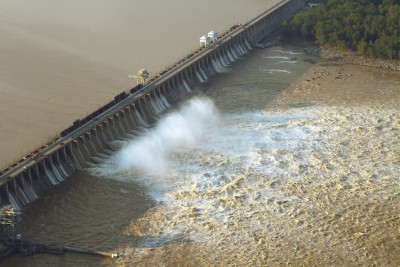
View of the Conowingo Dam on the Susquehanna River in the aftermath of Tropical Storm Lee taken Sept. 12, 2011. Discharge at time of the photo was 220,000 cubic feet per second. Peak discharge for the flood was 778,000 cubic feet per second at 4 a.m. on Sept. 9, 2011. (Photo: Wendy McPherson, U.S. Geological Survey)
The millions of gallons of water laden with polluted sediment pouring from the Conowingo Dam on the Susquehanna River after Superstorm Sandy are a far bigger problem for the Chesapeake Bay than local stormwater runoff, Republican elected officials said during a press conference last Thursday.
Standing in the spray from the gushing dam as huge flocks of seagulls and a bald eagle dove for fish, the officials complained that the federal Environmental Protection Agency’s mandatory pollution reduction will cost local taxpayers hundreds of millions of dollars while the Susquehanna pollution is being ignored.
Harford County Executive David Craig said, “One storm like this completely does away with 20 years of work” on local pollution controls.
“The EPA and the state of Maryland are not including the impacts of major storms in their bay pollution models,” said Senate Republican leader E.J. Pipkin of Cecil County. “Before the state and counties commit to such heavy expenditures, Maryland should evaluate whether these efforts, in light of the Susquehanna’s polluting potential, will be in vain.”
The officials cited an August study from the U.S. Geological Survey that the Conowingo and two other upriver dams were reaching their capacity to control pollution. The report said that last year’s Tropical Storm Lee contributed 39% of the sediment into the bay over the entire decade, along with 5% of the nitrogen pollution and 22% of the phosphorus.
But Beth McGee, a senior scientist with the Chesapeake Bay Foundation who attended the news conference, called the issue of the dam’s capacity to trap pollution “a red herring” since the creeks and tributaries of the bay in Maryland are polluted by local sources.
The Susquehanna River watershed, which stretches through much of Pennsylvania up to New York, supplies almost half the fresh water to the Chesapeake. Craig scoffed at the idea that Pennsylvania was attempting to control pollution from its farm and stormwater runoff.
But McGee said that Pennsylvania was “making progress” and “pollution is going down,” and “they don’t even benefit from the bay.” She cited other Geological Survey studies that showed declining nitrogen pollution from the Susquehanna watershed.
Pipkin was disappointed at the reaction of the Bay Foundation to the problem of pollution from the dams.
“They’re not talking about this” at the Bay Foundation, Pipkin said. “They’re more worried about control than they are about the bay.”


